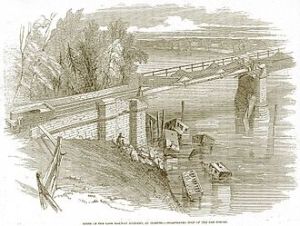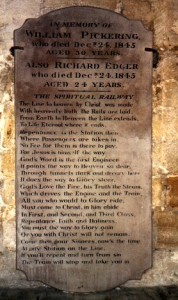8th September 1780. Cast, Wrought-Iron and Steel.
The Railway Regulation Act 1840 saw the first appointment of Railway Inspectors appointed by the Board of Trade.(1)
One of the first appointments as Inspector-General, was in 1841 with Major-General, Charles Pasley (R.E.), who born Today in 1780, witnessed the era of the canal and stage-coach.
The practice of appointing a Royal Engineer (RE), to the post was be followed until discontinued in 1988 with Major Rose (RE).(2)
One of the first accidents for the Inspectorate was at Howden, Yorkshire, on 7th August 1840 on the Hull-Selby Railway, when a casting fell from the first truck, derailing the rear passenger carriages, killing four. At that time freight and passenger traffic was combined.
In 1840 alone there were five railway accidents, with most at the time being ascribed to boiler explosions.
Many of the early spectacular disasters resulted from bridge failures, due to the widespread use of cast-iron or un-trussed girders on beam bridges, strengthened by wrought-iron.
Dee Bridge, Chester was one such example having been built for the Chester and Holyhead Railway.
Disaster came in May 1847, when the train to Ruabon fell through the bridge killing five.
The structure completed in September 1846, ironically had been approved by the then Railway Inspector, General Pasley.
It had been designed by Robert Stephenson, who was charged with negligence.
The weakness again, was that it was made of cast-iron, which is strong in compression, but in tension (bending) weak. It was later rebuilt in wrought iron.
Other bridge disasters reported at that time, as due to cast-iron use, occurred on 26th September 1860, on The Midland Railway at Bullbridge, Derby, and 11th June 1861, at Kenilworth Warwickshire, on the London and North-West Railway (LNWR).
The most momentous collapse was of the Tay Bridge on 28th December 1879, in a Force 11 gale, taking train and 75 passengers with it.
It was so buffeted by the gusting winds that its thirteen central girders were blown into the water. This finally undermined any confidence in cast-iron bridges.
This disaster led to steel being used on the Forth Rail Bridge, by chief engineer, Sir John Fowler in the 1880s.(3)
In 1919 The Railway Inspectorate became part of the new Ministry-of-Transport.
(1) Royal Assent for Act given on 10th August 1840.
(2) Appointed on 23rd November 1841. He died 19th April 1861.
(2b) As Engineers they were used to running the army rail system.
(3) Until Bessemer there were only two types: cast iron which was brittle owing to its higher carbon and used for engine cylinders.
Then wrought iron, much stronger, and which could be forged, rolled and shaped in various ways, the material of bridges, ships and machine parts.
Steel alloy of iron contains carbon and the higher the carbon, the more hard and brittle steel results. Other metals are added for the desired properties.
Ref: wikipedia.org/general_pasley/Dee Bridge image.
Ref: victorianweb.org/technology/railways.
Ref: Ely Memorial image/wikipedia.org.
Ref: bl.uk/romantics-and victorians/articles/railways-in-victorian-fiction.
ADDENDA:
The true measure of Victorian mawkishness is seen at Ely Cathedral where a memorial slab commemorates two men killed on the Norwich-Ely Railway in 1845.
Pevsner regarding the memorial verse below, described the ’eminently character of earnestness with which the new triumph of human ingenuity is still regarded’.
The opening lines are:’The Line to Heaven by Christ was made/with heavenly truth the Rails were laid’.
Pasley’s predecessor General John Smith, inspected and reported on the London-Birmingham Railway pre-opening.
On 5.7.1845 Smith was on the Commission looking into the idea of providing for a standard gauge, not to be achieved until 1892.

